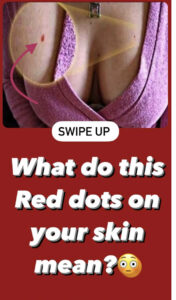.
🔴 Red Dots on Your Skin: Causes and What They Could Mean
They appear suddenly. Sometimes they itch, sometimes they don’t. Sometimes they’re raised, sometimes flat. Whether it’s one dot or a constellation of them, red spots on the skin can be alarming. But not all red dots are created equal—and understanding their cause is the first step toward peace of mind.
Here’s a deep look at the most common causes, what they might mean, and when to seek help.
1. Acne Vulgaris
- What it looks like: Small red bumps, often with whiteheads or blackheads.
- Where it appears: Face, chest, back, shoulders.
- Why it happens: Blocked pores due to oil, dead skin, and bacteria.
- What it means: Your skin is reacting to hormonal changes, stress, or poor skincare habits.
- Treatment: Over-the-counter salicylic acid or benzoyl peroxide; prescription retinoids for severe cases.
2. Cherry Angiomas
- What it looks like: Bright red, dome-shaped bumps.
- Where it appears: Torso, arms, shoulders.
- Why it happens: Clusters of dilated blood vessels.
- What it means: Harmless growths often associated with aging.
- Treatment: Usually none needed unless for cosmetic reasons; can be removed with laser therapy.
3. Petechiae and Purpura
- What it looks like: Tiny red or purple dots that don’t fade when pressed.
- Where it appears: Legs, arms, torso.
- Why it happens: Bleeding under the skin due to broken capillaries.
- What it means: Could signal trauma, infection, or a blood clotting disorder.
- Treatment: Depends on the underlying cause—urgent medical evaluation may be needed.
4. Contact Dermatitis
- What it looks like: Red, itchy patches or dots.
- Where it appears: Anywhere skin touches an irritant (e.g., wrists, neck, hands).
- Why it happens: Allergic reaction or irritation from soaps, fabrics, or chemicals.
- What it means: Your skin is protesting something it doesn’t like.
- Treatment: Remove the irritant, use antihistamines or hydrocortisone cream.
5. Heat Rash (Miliaria)
- What it looks like: Tiny red dots or blisters.
- Where it appears: Armpits, groin, neck, under breasts.
- Why it happens: Sweat trapped under the skin.
- What it means: Your body’s cooling system is overwhelmed.
- Treatment: Cool compresses, loose clothing, and staying out of the heat.
6. Guttate Psoriasis
- What it looks like: Small, red, scaly dots.
- Where it appears: Torso, limbs.
- Why it happens: Autoimmune response, often triggered by a respiratory infection.
- What it means: Your immune system is attacking healthy skin cells.
- Treatment: Topical steroids, phototherapy, or systemic medications.
7. Lichen Planus
- What it looks like: Flat-topped, reddish-purple bumps.
- Where it appears: Wrists, ankles, lower back.
- Why it happens: Autoimmune reaction, sometimes triggered by medications or infections.
- What it means: Your immune system is misfiring.
- Treatment: Corticosteroids, antihistamines, or immunosuppressants.
8. Infections (Viral, Bacterial, Fungal)
- Examples:
- Chickenpox/Shingles: Clusters of itchy red dots that blister.
- Cellulitis: Painful red patches caused by bacterial infection.
- Ringworm: Red circular patches with raised edges.
- What it means: Your skin is fighting off an invader.
- Treatment: Antivirals, antibiotics, or antifungal creams depending on the cause.
9. Hives (Urticaria)
- What it looks like: Raised, itchy welts that may merge into larger patches.
- Where it appears: Anywhere on the body.
- Why it happens: Allergic reaction to food, medication, or stress.
- What it means: Your body is releasing histamines in response to a trigger.
- Treatment: Antihistamines, avoiding known allergens.
10. Keratosis Pilaris
- What it looks like: Small, rough red bumps, often mistaken for acne.
- Where it appears: Upper arms, thighs, cheeks.
- Why it happens: Buildup of keratin blocking hair follicles.
- What it means: A harmless but persistent skin condition.
- Treatment: Exfoliating creams, moisturizers with lactic acid or urea.
🧠 When to Worry
While many red dots are harmless, some may signal serious conditions. Seek medical attention if:
- The dots don’t fade when pressed (possible petechiae).
- They’re accompanied by fever, fatigue, or joint pain.
- They spread rapidly or become painful.
- You have a history of bleeding disorders or are on blood thinners.
🧴 Treatment & Prevention Tips
- Gentle skincare: Avoid harsh soaps and exfoliants.
- Hydration: Keep skin moisturized to prevent irritation.
- Sun protection: Use SPF to avoid sun-induced rashes.
- Allergy management: Know your triggers and avoid them.
- Medical checkups: Regular skin exams can catch issues early.
🌼 The Emotional Side of Skin
Skin isn’t just a barrier—it’s a billboard. Red dots can trigger anxiety, embarrassment, or fear. But they’re also messages. Your body is speaking. Whether it’s stress, inflammation, or infection, these dots are clues.
And like all clues, they deserve attention—not panic.
Final Thoughts
Red dots on your skin can mean many things—from a harmless cherry angioma to a sign of something deeper. The key is observation, education, and when needed, consultation. Your skin is your largest organ, and it’s always trying to tell you something.
So the next time you spot a red dot, don’t just cover it up.
Ask it what it’s trying to say.



